Gather ’round the piano, L.A.
March 30, 2012
The pianos are coming—and the Los Angeles Chamber Orchestra hopes Southern California is ready to play.
In an initiative that will involve artists, community groups and businesses from throughout the region, 30 upright pianos will be dispatched to street corners, public parks and assorted outdoor locations throughout Greater Los Angeles this month just to see what transpires around them.
They’ll be free, available 24-7, tuned by professionals, decorated by some of L.A.’s most talented artists and equipped with plastic covers in case of bad weather. All the public will have to do will be to follow the instructions that will be written on each one:
“Play Me, I’m Yours,” the inscription will say.
“I’d read about this in London and New York, and thought it was a spectacular idea,” says LACO Executive Director Rachel Fine, who began laying the groundwork for the initiative even before she officially started her job at the orchestra in late 2010.
The pianos will be placed across the Southland, from North Hollywood’s El Portal Theatre to the Watts/Willowbrook Boys & Girls Club, from Atlantic Times Square in Monterey Park to Union Station and the Santa Monica Pier.
The endeavor, which will run from April 12 until May 3, is part of a worldwide public art project launched in 2008 in Birmingham, England, by British artist Luke Jerram. Placing temporary pianos outdoors where people can stumble upon them and, perhaps, make music, the “Play Me, I’m Yours” street piano project has so far set up more than 500 pianos in 22 cities.
Though “Play Me” has generated random acts of community and music from Sao Paulo to Sydney, it has been little known in this country, Fine noted. So far, the only American cities in which the project has appeared are Austin, Cincinnati, Grand Rapids and New York. This year’s schedule includes Salem, Ore., and Salt Lake City, in addition to L.A.
Fine called the project “a major undertaking,” but said she and the orchestra’s board members felt early on that it would be a perfect way for the orchestra to celebrate Music Director Jeffrey Kahane’s 15th anniversary with LACO and to reach out across L.A.’s metropolitan sprawl. Kahane, she noted, is a renowned pianist, and one of the orchestra’s priorities has been to remind Angelenos that it’s there as a community resource.
In fact, the organizers were still reaching out on Twitter this week for the last couple of uprights, although by the end of the day Friday, pianos had been secured for all 30 locations, thanks to donations facilitated by the Hollywood Piano Company.
Fine said that wherever “Play Me, I’m Yours” has gone, it has generated thousands of impromptu concerts, YouTube videos, dance parties, sing-alongs and jam sessions. Some artists have made it a point to play every piano.
And, she noted, the pianos themselves might be seen as “blank canvases”, which is why more than a dozen well-known Southern California artists, including muralist Kent Twitchell and painter Frank Romero, have been commissioned to decorate them, as will community groups such as the Braille Institute, the HeArt Project and Homeboy Industries.
“I’ve seen some of the painted pianos already,” says Fine, “and they’re exquisite.”
Backers include corporate citizens such as the Wells Fargo Foundation and community partners such the Los Angeles City Department of Cultural Affairs, Fine says.
The event will kick off precisely at noon on Thursday, April 12, with a free, countywide, performance of Bach’s “Prelude No. 1 in C Major” from the “Well-Tempered Clavier,” played simultaneously on all the pianos by Kahane and 29 other accomplished pianists and music students from around L.A.
After that, each musician will play one more Bach prelude and a selection of pieces of their own choosing. And then, for the next three weeks, it will be first-come, first-served for anyone else who wants to tickle the ivories.
“This is by far the most ambitious presentation of the installation to date,” the artist, Jerram, said in a statement. “I hope the public enjoys the project and takes advantage of the opportunity to perform, express themselves and go out and play.”
For the piano nearest you, go to streetpianosLA.com or click here. And for even more video highlights of “Play Me, I’m Yours” in other cities, click here.
Pacific Standard Time free-for-all
March 29, 2012
It’s the eleventh hour for Pacific Standard Time, the Getty initiative that celebrates the Los Angeles art scene from 1945-1980. If you want a last look, or even a first look, you’re in luck—many museums that participated in PST are having a Free Admission Day with special programming to give the event a proper sendoff.
The following museums will waive admission fees on March 31:
American Museum of Ceramic Art
Eames House Foundation (reservations required)
The J. Paul Getty Museum (parking is $15)
The Grammy Museum
Los Angeles County Museum of Art
Mingei International Museum
ONE National Gay and Lesbian Archives (West Adams and West Hollywood)
Pacific Asia Museum
Palm Springs Art Museum
Pasadena Museum of California Art
Pomona College Museum of Art
Santa Barbara Museum of Art
These museums are celebrating the send-off of PST, and are always free:
Art, Design & Architecture Museum, University of California, Santa Barbara
California African American Museum
Chinese American Museum (admission is donation-based)
Fisher Museum of Art, University of Southern California
Los Angeles Nomadic Division (LAND)
Scripps College, Ruth Chandler Williamson Gallery
Posted 3/29/12
A measure of good news?
March 29, 2012
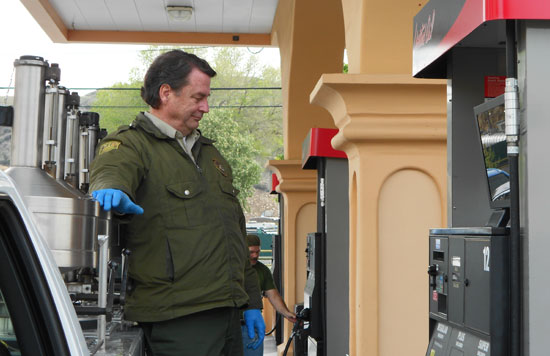
L.A. County inspector Mark Smith says 94% of pumps are accurate, with mistakes often favoring consumers.
The price of gas may not be particularly reassuring, but Mark Smith may have some comforting news.
An inspector with the Los Angeles County Bureau of Weights and Measures, Smith is part of a 13-person unit that monitors the county’s 55,000-plus gas pumps. His mission? To make sure beleaguered consumers get what they pay for at the gas pump. His message? Ninety-four percent of the time, they do.
“When the price of gas is real high, like it is now, people ask me about four times a day if the gas pumps are in compliance,” said Smith, pulling up to a bank of pumps at a United Oil station in Santa Clarita on a recent morning. The sun gleamed on the aluminum tanks of his specialized testing truck. Around him, glum-looking motorists stood, filling their tanks and averting their eyes from the gas meters as the dollars flew by.
“This has gotta be wrong!” exclaimed Santiago Cardenas from the next pump as his mid-sized Mazda SUV guzzled gallon after gallon. “I notice the needle is at not more than half the tank and it’s already at $55!”
“When gas prices spike, usually so do consumer complaints,” Smith noted. “People say, ‘I know my tank holds 20 gallons and I just pumped 21,’ or ‘I just put six gallons in a 5-gallon can—I’m being shorted.”
In fact, Smith explained to Cardenas, owners’ manuals and gas gauges are notoriously inexact when it comes to conveying the precise capacity of a gas tank.
“If your owner’s manual says 20 gallons, you can probably put as much as 22 in it, and if your gauge says a half or a quarter of a tank, you could have anything around there. I’ve been on hundreds of complaints like that and they’re almost never valid,” Smith said.
Smith and his colleagues operate as a sort of team of “gas busters” for haunted consumers who often drive away from the pump wishing they knew whom to call for relief. Each year, the team checks each grade of fuel at each pump at each of the county’s 1,900-plus gas stations; inspectors also investigate every complaint received by the department, usually within hours.
“We had, like, a 150 percent increase in complaints earlier this year when the price of gas went way up,” said Laurence Nolan, who heads the bureau. In less stressful times, Nolan said, the bureau averages about 500 complaints annually.
Though an inspection involves scores of issues, from equipment to handicapped signage, the pumps are subjected to a fairly straightforward test: A pickup truck equipped with four 5-gallon measuring devices—one for each of the usual grades of gasoline and one for diesel—is pulled up next to the tank. Then five gallons are pumped into each receptacle to see if the pump’s measurements and the county’s match.
If the reading is off by more than 6 cubic inches, or about 3 ounces, the owner is cited and given 30 days to fix the problem. If the error is in the consumer’s favor, the station can decide whether to let the pump continue operating, but if the consumer is being shorted, the county shuts down the pump until it’s repaired.
Fines range from about $150 to $600 per violation, depending on whether the station owner is a repeat offender, said Nolan. After the test, the gas collected by the inspector is drained back into the station’s underground tanks.
Over the years, scams occasionally have been uncovered. In 1999, for instance, a gas station owner and his brother pleaded guilty to felony conspiracy charges after they were caught outfitting pumps at a dozen Southern California Mepco stations with computer chips that generated fraudulent readings.
And last year, a West Covina gas station owner was charged with false advertising after he repeatedly removed parts of the price numbers from his double-sided price signs, leading motorists to believe he charged less than a neighboring gas station.
But the vast majority of station owners are honest, Smith and Noland said, and the pumps are usually accurate to within a couple of teaspoons per gallon. The most common problems involve meters that either start registering a purchase before the consumer starts pumping, or continue running after the consumer stops pumping—“jump” and “creep”, in gas pump parlance. Both generally stem from faulty hoses and nozzles and are easily fixed, Smith said.
“Only about 6 percent of the pumps we check have to be tagged for being out of compliance,” said Nolan. And, he added, the majority of those violations are either borderline or in the consumer’s favor. At that Santa Clarita gas station, for instance, only one pump out of 38 was off-kilter—and it was dispensing too much gas.
“The owners here are losing about four cents a gallon,” Smith observed, adding that consumers also often believe, inaccurately, that station owners are getting rich from the gas crunch.
“Mostly what I hear from station owners is that they can’t believe they’re still in business, they’re making so little profit,” Smith said. “Especially the mom-and-pops. It’s tough out there.”
Still, every penny matters, and Smith does have some advice for consumers.
“When you authorize the pump, look at it for five seconds before you start pumping. See whether the reading jumps. And when you’re done pumping, before you hang up the nozzle, watch again to see whether it creeps up.
“If it does, tell the attendant, tell them what happened and they should refund your money or reauthorize it so you don’t get charged for it.”
If your concern isn’t satisfactorily handled, or you still feel overcharged, you can contact the bureau toll-free at 800 665 2900 or write them at Los Angeles County Agricultural Commissioner/ Weights & Measures Bureau, 11012 Garfield Ave. , South Gate, CA 90280. Or complete an online complaint form here.
Posted 3/29/12
CicLAvia wants YOU
March 29, 2012
The countdown to the next CicLAvia has started, and organizers have put out an APB for volunteers interested in lending a hand toLos Angeles’ 10-mile celebration of car-free streets.
Volunteers are essential to helping manage the April 15 event in which tens of thousands of people are expected to bicycle, jog, stroll and engage with each other along a route that runs from the Bicycle District in Hollywood to East L.A., and from El Pueblo de Los Angeles to the African American Firefighter Museum south of downtown.
“They are the lifeblood of CicLAvia, for sure. We couldn’t even dream of doing CicLAvia without them,” said Martin Lopez-Iu of the Los Angeles County Bicycle Coalition, who is coordinating the volunteer effort.
Leading up to CicLAvia, volunteers will receive information and training where needed. Then the week before the event, some volunteers will prepare signs and distribute parking notices to residents and businesses. On the day of CicLAvia, volunteers will sell merchandise and distribute information at route hubs, where people stop for water, bike repairs, first aid and entertainment.
New this year, the “Adopt an Intersection” program allows schools, businesses, organizations, and other groups to take responsibility for “soft-closure” intersections. It will be their responsibility to manage pedestrian and bike traffic and allow cars to pass through. The program is also a chance for groups to transform the intersection into their own miniature block party by setting up tables, playing music, putting on a show or creating public art.
Lopez-Iu hopes putting groups in charge of the intersections will help slow people down and look at the communities around them.
“We really want people to get off their bikes, walk around, check out the people and eat at restaurants,” he said.
CicLAvia takes place Sunday, April 15, from 10 a.m. to 3 p.m. If you’re interested in helping out, sign up or find out more by emailing [email protected]. All volunteers will receive a free T-shirt, and the hours can be used to fulfill service credit requirements.
Posted 3/29/12
Eating it up on the Expo Line
March 28, 2012
They dubbed it the Pastrami Express. When the Red Line subway came to Langer’s MacArthur Park neighborhood in 1994, offering a convenient way for downtown workers to get their pastrami-on-rye fix, it touched off a transit-driven boom for the legendary delicatessen, family-owned since 1947.
After an inaugural weekend of free rides on the new subway, deli owner Norm Langer showed up Monday and was met with a miraculous sight: customers, by the hundreds.
“I had 500 people on a waiting list,” he recalled. It was a welcome turnaround for a business suffering at the time from demographic shifts and high crime in the neighborhood. “My light at the end of the tunnel was the Red Line,” he said. “If it didn’t open, we would have closed.”
Today, business is better than ever in a revitalized neighborhood, Langer said, continuing to marvel at the Red Line effect. “It’s phenomenal. And it gets better over the years because there are more lines that tie into it. We’ve had a great resurgence of our customer base because of it.”
Now a new generation of restaurateurs, business owners and cultural institutions is looking to another much-anticipated public transit project—the Expo Line—and hoping that the gravy train will soon be pulling up to their establishments, too.
Make that the chili, hot dog, fresh fish and cobbler train.
Earlez Grille is among those preparing for an influx of newcomers when the first Expo trains roll out on April 28.
“It’s a great thing,” said Cary Earle, who owns the establishment with his brother Duane and mother Hildred. The Grille’s location—beside the Crenshaw station and a few stops away from the University of Southern California—is prime, he said. “It’s going to give us a lot of USC students.”
First-time visitors should try the basics, he said: a beef hot dog with mustard and cooked onions, washed down with a Playa’s punch, a non-alcoholic mixture of red fruit drink and lemonade.
The restaurant, on the former site of Jack’s Chili Factory, also specializes in chili made from Jack’s original recipes. On a recent Expo Line test run for the media and elected officials, Metro CEO Art Leahy said he’s looking forward to eating there once Expo opens. “It will now be a hot downtown lunch spot,” he predicted.
Another potential hot spot is Mel’s Fish Shack on Jefferson Boulevard, a short walk from Expo’s Farmdale station, which is slated to open later in the spring, after the initial rollout.
“I pray that it will bring us a windfall of customers,” owner Georgette Powell said, sitting at the counter of her tiny eatery, where cooks like Jerry Rhodes fry up corn flour-dusted catfish, snapper and shrimp along with healthy innovations such as grilled salmon salad and tilapia wrap with dill sauce.
“I have felt isolated for many years” in terms of the accessibility of her location, said Powell, 44, who learned the business from her late father, Mel. “The train makes us more desirable.” Powell hopes eventually to expand Mel’s to other locations and perhaps start a community-based culinary school to train aspiring cooks in the “healthy soul food niche.”
Some, however, are skeptical about the train’s ability to deliver new customers.
“Will anybody walk over two blocks, when they’re traveling from Point A to Point B? I don’t think so,” said Carolyn McMillan, co-owner of The Kobbler King on Jefferson, near the Crenshaw station. Those who do make the trip, however, should try one of the savory cobblers like chicken or seafood, she said, with berry cobbler for dessert. “Peach and apple are good, don’t get me wrong, but I like the berries,” she said.
Initially, the Expo Line will travel between Metro’s 7th Street Center downtown and La Cienega/Jefferson. Some of its marquee destinations are big, internationally known venues—Staples Center, USC, the county Natural History Museum, the Coliseum. The California Science Center is expecting a “significant increase” in attendance, buoyed in part by the Expo Line and also by anticipated blockbuster shows devoted to Cleopatra, and, later, the Space Shuttle Endeavour.
But smaller venues, like the Lula Washington Dance Theatre near the Crenshaw station, are also hoping for a boost in visibility. “The main impact is that people will go by our place and see us,” said Executive Director Erwin Washington, who noted that many of the troupe’s dancers and students will also have an easier time getting to the theatre on the Expo Line.
At the California African American Museum, served by the new line’s Expo Park/USC station, director Charmaine Jefferson said staff at the admission-free museum would also have a better commute to work. In addition, having a light rail option should help overcome one of the major downsides of its location near the Coliseum: patrons who stay away on sporting event game days. “You’ll have guests who’ll say, it’s going to be a zoo; I don’t want to go there,” she said.
The rollout of the first phase of the Expo Line will culminate with the opening of the Culver City station at Venice and Robertson, expected this summer.
At Culver City’s quirky Museum of Jurassic Technology, archivist and administrator Hana van der Steur said the train will be a benefit for current visitors and supporters—as well as those who have yet to discover the collection of oddities and treasures.
“We’re basically ecstatic to have it,” she said. “We’re really hoping that people will take advantage of it. The museum is the kind of place that you really have to visit in order to get a good sense of it.”
Among owners of Culver City’s many eateries, there’s some uncertainty about what the station opening will mean for the area, already known as a dining destination for many on the Westside, said Ken Kaufman, the owner of Rush Street and City Tavern, who also serves on the board of the Culver City Downtown Business Association.
“We’re not sure of it. We know that the culture of L.A. is a car culture, and we don’t know how quickly people will adapt to using the train,” he said. “We don’t expect it to have a significant effect, but we hope we’re wrong.” He said a much bigger impact is expected four years from now—when Expo Phase 2 opens from Culver City to Santa Monica, giving traffic-challenged Santa Monicans a quicker route to dinner.
“As someone who takes reservations,” he said, “everybody knows that people who come from Santa Monica are always a half hour late.”
For a sampling of other attractions along the Expo Line route, check out Metro’s Destination Guide.
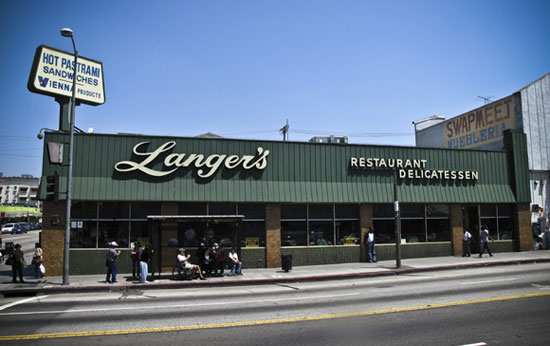
Langer's Deli says the Red Line saved its business in the days of high crime in the MacArthur Park neighborhood.
Posted 3/29/12
Homeless team gets to work
March 28, 2012
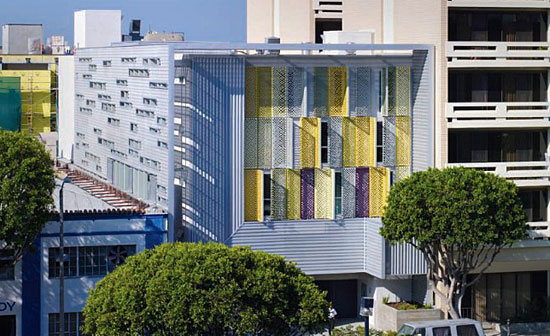
Homeless service provider Step Up on Second built this Santa Monica complex for permanent supportive housing.
The occasion was the inaugural meeting of the Interdepartmental Council on Homelessness, a body created through a Board of Supervisors motion authored by Mark Ridley-Thomas and myself. And make no mistake, despite the bureaucratic-sounding name, the council will make a measurable impact on homelessness because, for the first time, we’re pursuing a clearly defined county strategy: to provide permanent supportive housing with vital services to those most likely to perish on our streets.
In other words, if you want to end homelessness, then you must provide a home.
We know from our own experience that this “housing first” approach works. Back in 2007, in that same Hall of Administration conference room, we launched a pilot program called Project 50, championed by my office to house and provide supportive services to Skid Row’s 50 most chronically homeless people. Unlike earlier, narrower efforts, this one required coordination among multiple county agencies with varying responsibilities for this extraordinarily difficult population.
The goal was not only to save lives, but to save money, too, by reducing the high public cost of emergency room care and incarceration historically associated with chronically homeless individuals.
Since the successful launch of Project 50, the concept has been replicated throughout my 3rd District—in Santa Monica, Venice, Hollywood and the San Fernando Valley. The United Way has adopted the approach for its ambitious “Home for Good” campaign, as has the Department of Veterans Affairs with its own Project 60 in collaboration with my office. In all, more than 500 people have been placed in permanent supportive housing since the initiation of Project 50.
Now, with the establishment of the interdepartmental council, Los Angeles County is finally aligning its will and existing resources behind the housing-first model, offering real hope to the most vulnerable among the 51,000 souls in our county without homes. Around the table on Wednesday were top officials from such crucial departments in the fight against homelessness as mental health, children and family services, probation, health services, public health, social services, community development, the superior court and sheriff’s department.
To be sure, we face a huge challenge here, in the nation’s epicenter of homelessness. And our vast county bureaucracy is not naturally inclined toward this kind of multi-agency plan of attack, one that eliminates barriers and accelerates the time between an idea and its implementation.
Still, as the council’s first chairman, I’m convinced that in the months and years ahead we can house not just hundreds, but thousands of people who, like any other resident of our county, deserve more than another well-intentioned plan that ends up on a shelf gathering dust.
Posted 3/28/11
Subway makes tracks toward Westwood
March 23, 2012
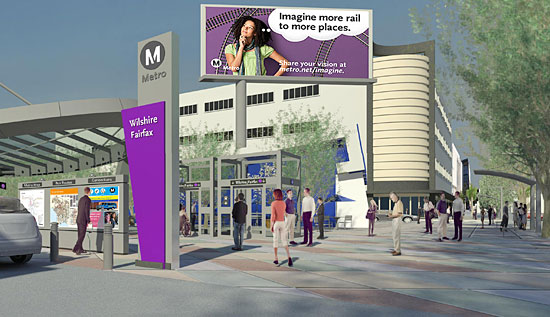
The subway's 7 proposed stations, most along Wilshire, could look something like this, at Fairfax near LACMA.
Metro officials today unveiled final environmental documents for the Westside Subway, detailing a 9-mile extension of the existing Purple Line subway with seven recommended stops, including a Century City station at Constellation Boulevard and Avenue of the Stars—a location approved by a panel of top scientists but hotly contested by some officials in Beverly Hills.
The release of the final environmental reports marks a significant milestone for the project, which has been in the planning stages for more than four years. When completed, the subway is expected to log 78,000 trips a day and make it possible to travel from downtown L.A. to Westwood in 25 minutes.
While the project will benefit riders throughout the region, its impact will be felt most strongly on the Westside, which has a heavy concentration of jobs along with some of the worst traffic in the nation.
“This is a project that Los Angeles has been talking about for at least a half a century,” said Jody Litvak, Metro regional communications manager. She called the release of final environmental documents “a huge accomplishment” and a “delivery to voters on the promises of Measure R,” the ½-cent sales tax that will partially fund the subway.
The Westside Subway would begin where the Purple Line currently ends, at Wilshire and Western. The new stations would be located along Wilshire at La Brea, Fairfax, La Cienega and Rodeo Drive, as well as in Century City, at UCLA and at the V.A. Hospital.
The siting of the Century City station has been controversial. Because the route to get to the proposed Constellation station would pass under the Beverly Hills High School campus, some city officials have raised safety concerns about tunneling in the area and urged that the Century City station be built instead under Santa Monica Boulevard.
But last year, a panel of high-profile scientific experts convened by Metro said that active earthquake faults make the Santa Monica Boulevard location too dangerous for a subway station. These experts, including Lucy Jones of the U.S. Geological Survey and Caltech, found instead that a station could be safely built at the Constellation site, which has no evidence of active faults. In addition, they said that tunneling under the high school property could be accomplished safely with state-of-the-art equipment and techniques even through earthquake zones and ground with large concentrations of methane gas.
Beverly Hills hired experts of its own to review Metro’s scientific conclusions. Those experts argue that more research is needed, particularly around the Constellation site and on the high school campus. (The city’s website has links to those reports, as well as other information on Beverly Hills’ position on the subway.) In addition, the Beverly Hills school board recently commissioned widespread trenching studies on the high school campus to determine whether seismic hazards are present; a report on that is expected soon.
Metro officials say the final environmental documents released today make it clear that it will be safe to build a subway station at Constellation, but said they will be studying the Beverly Hills reports carefully. (Updated: The Beverly Hills School District’s attorney, Kevin Brogan, issued a statement criticizing Metro for releasing the final environmental documents before receiving the results of the trenching studies. His statement is here.)
Agency officials said the Constellation station also would attract more riders and be closer to more jobs than the Santa Monica Boulevard station. The agency projects 8,600 boardings at Constellation each weekday, compared to 5,500 boardings at Santa Monica Boulevard.
The final environmental reports also studied various alternatives for the two stations in Westwood. For the UCLA station, the report recommends a location on Wilshire at Westwood Boulevard. At the V.A. Hospital, it recommends building the station on the south side of Wilshire at Bonsall Avenue, in the northern edge of the hospital’s parking lot just west of the 405 Freeway.
Plans call for the subway to get to Wilshire and La Cienega by 2020, to Century City by 2026 and to the Westwood V.A. Hospital by 2036. However, some officials, including Metro Board Chair and Los Angeles Mayor Antonio Villaraigosa, are pressing for the entire project to be completed much sooner—by 2022—under an accelerated building program known as America Fast Forward.
Metro has estimated the cost of the project at $5.66 billion in 2022 dollars, but that could rise to an estimated $6.29 billion if the project takes until 2036 to complete. Some funding will come from Measure R but more will be needed from the federal government’s “New Starts” program.
The final environmental documents are scheduled to go before Metro’s Board of Directors on April 26. If the board votes to certify the project, the Federal Transit Administration will be asked to sign off on the plans and formally conclude the federal environmental review phase of the project. Then, final design work is expected to take about a year, with groundbreaking slated for sometime in 2013.
A series of informal community open houses are scheduled next week so that people can learn more about the project and see artists’ renderings of what some of the stations could look like. They will be held on Monday, March 26, at the Los Angeles County Museum of Art; on Wednesday, March 28, at Westwood United Methodist Church; and on Thursday, March 29, at Temple Emanuel in Beverly Hills. Each of the meetings will run from 5 p.m. to 7:30 p.m. Additional details and parking information are here.
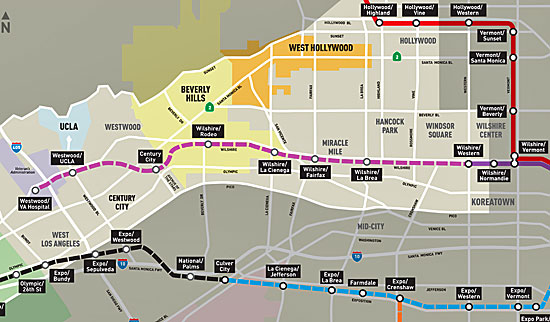
The 9-mile extension of the Purple Line starts at Wilshire and Western and ends at the VA Hospital in Westwood.
Posted 3/19/12
It’s a date: Expo to roll in April
March 23, 2012
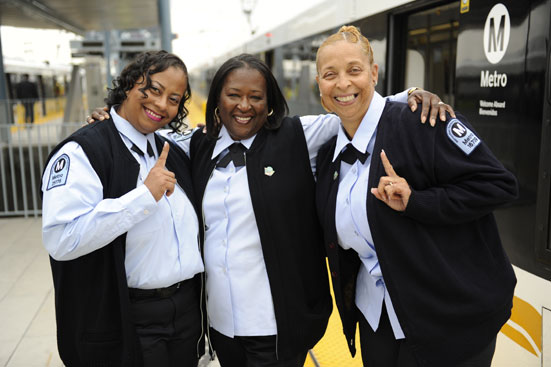
Train operators are ready to roll. From left, Narvolean Jackson, Carolyn Kelly and Sheila Celestain. Photo/Metro
After months of testing and delays, the much-anticipated Expo Line light rail will start carrying passengers on April 28, officials announced today.
Riders will be able to jump aboard for free during the line’s inaugural weekend, April 28 and 29. Metro Board Chair and L.A. Mayor Antonio Villaraigosa announced the opening this morning at a news conference with Supervisor Zev Yaroslavsky, Exposition Authority chair and Metro board member, and Metrolink chair Richard Katz.
“Some of us didn’t think we’d live long enough to see this day, but we’ve made it,” joked Yaroslavsky, standing on the platform of the new station at La Cienega and Jefferson. “This is the first light rail line, mass transit line, to serve the Westside of Los Angeles since the Red Car was dismantled in the 1950s, so this is a huge deal.”
After the announcement, the elected officials, Metro staffers and members of the news media hopped aboard Expo Line Train 246 for a standing-room-only ceremonial trip from La Cienega to downtown.
At first, the new line will run from Metro’s 7th Street Center downtown as far as the La Cienega station. Paralleling the notoriously jammed 10 Freeway, the Expo Line will open with 9 new stations, including USC, Western, Crenshaw and La Brea, and two stations shared with the Blue Line. In coming weeks, an additional station in Culver City is expected to open at Venice and Robertson, concluding the 8.6-mile Phase 1 of the project.
Meanwhile, Phase 2 is underway to extend the line 6.6 miles to 4th and Colorado in Santa Monica; it is expected to be completed in four years.
This interactive map shows how the entire 15.2-mile line will look when finished. It’s expected to eventually carry about 64,000 passengers a day, making it one of the most heavily-used lines of its kind in the country. The first phase is projected to carry about 26,000 riders a day.
“Every time we add a leg to our regional transportation network, it’s a whole that is bigger than the sum of its parts,” Yaroslavsky said. “When we finish this line to Santa Monica, you’ll be able to go from any part of Southern California to the beach. People who live near the beach will be able to go to any other part of Southern California. This line will now connect this community—the Crenshaw area, the Culver City area, ultimately Santa Monica—to the rest of the region.”
Testing on the $932 million first phase of the Expo Line has been underway since last fall, but the opening has been delayed several times to work out technical and logistical issues, including signal timing where the line intersects with the Blue Line at Washington and Flower.
Metro CEO Art Leahy said that problem has recently been worked out to allow trains to move through the intersection at regular intervals, without causing delays that could have rippled out throughout the system.
The Expo Line’s opening comes against a backdrop of rapid expansion of Los Angeles’ public mass transit network, once widely—and justly—derided as close to nonexistent.
In addition to the upcoming opening of the first part of the Expo Line, work has begun on the $1.5 billion Expo Phase 2, the northward extension of the Orange Line is nearly complete, final environmental documents for the Westside Subway have just been released and the Gold Line is expanding to Azusa, among other projects.
“There’s no city in the country, none, that is engaged in as ambitious an expansion of their light rail and subway system than L.A.,” Villaraigosa said.
Officials credited county voters will making it all possible by approving Measure R, the ½-cent sales tax for transit projects, in 2008.
“These are your tax dollars at work,” Yaroslavsky said.
Posted 3/23/12
For a preview of what’s in store, check out Supervisor Yaroslavsky’s Expo Line test ride in this video.
Kent Twitchell’s inside job
March 21, 2012

Kent Twitchell made his name as an outdoor artist whose enormous, hyper-realist outdoor portraits have become an indelible part of the L.A. landscape.
But there’s a downside to all that larger-than-life public visibility. He’s seen many of his iconic works disfigured by vandals and sometimes unceremoniously destroyed over the years. So it is with a sense of relief and renewed enthusiasm that he’s working on his latest project—a series of murals for the county’s downtown Bob Hope Patriotic Hall that will be displayed safely indoors.
Our video visit to Twitchell’s downtown L.A. studio offers some behind-the-scenes insights into this important work in progress, while the gallery below gives a sense of the breadth of his work, from the salvaged remains of earlier pieces to the prep work for such still-standing murals as “Harbor Freeway Overture.”
Twitchell was selected in 2010 for his role in the Patriotic Hall project, part of an extensive renovation. In coming months, his artwork, painted on mural fabric, will be moved from his studio and adhered and sealed to the lobby walls of the imposing 1926 building.
Posted 3/21/12




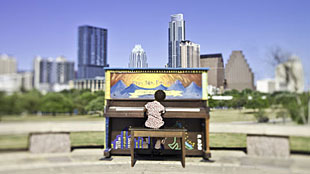
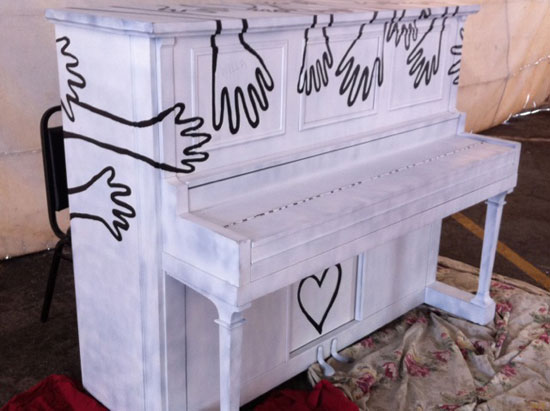
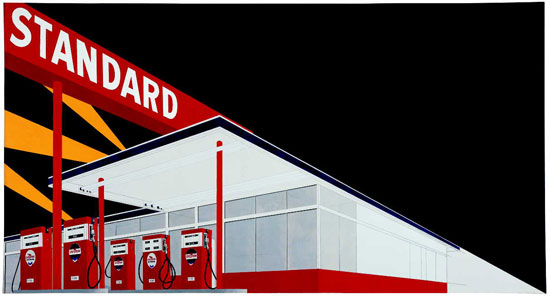
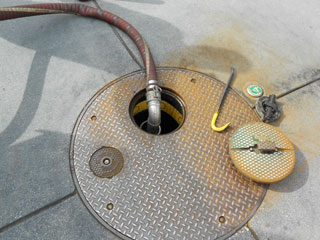

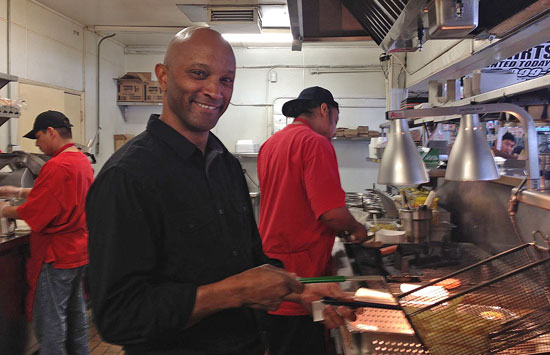
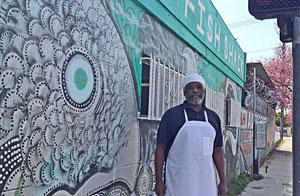
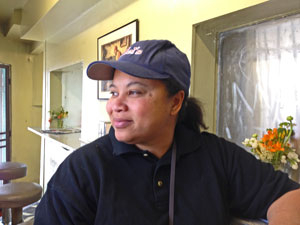
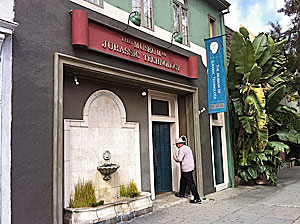
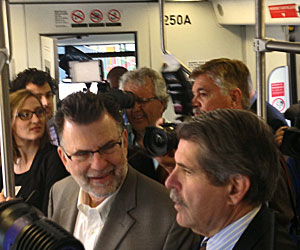
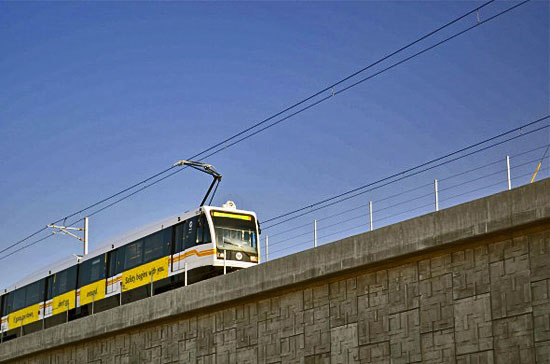










 Check for the latest closure information
Check for the latest closure information








